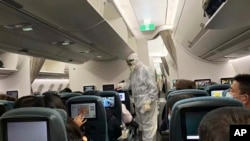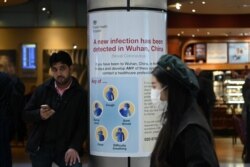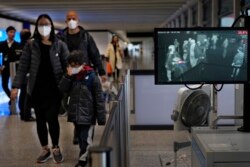The U.S. immigration officer shifted uneasily on his feet, and self-consciously told a handful of travelers exiting the fast-track Global Entry gate: "Oh, wait I have to ask you something. Has anyone traveled from China or…?"
He trailed off, seemingly scrambling to recall what else he was supposed to ask. "Oh, yes, and Iran?" We all said we had not. When he appeared to think he had forgotten something, I volunteered. "or Italy?" "Oh, yes, Italy," he concurred.
I responded I had, but that I had not been in the most affected parts of the country in the north. "Okay," he replied. And that was the end of my exhaustive screening at Washington's Dulles International Airport. There was no mention by the officer of the guidance from the Centers for Disease Control for all those arriving in the U.S. from Italy: "Travelers should stay home for 14 days after returning to the United States and practice social distancing."
I had flown indirectly to Washington from my home in Italy via London, where I spent a couple of days to report. When I arrived at London's Heathrow Airport from Rome, there was no questioning, screening or temperature checks at all, either. There was a notice at Heathrow's Terminal 5 about coronavirus, but placed in such a position that it was easy to miss.
For arrivals at Rome's main international airport or Paris' Charles De Gaulle it is all very different. At both those airports nearly all security and border staff wear high-quality face masks and gloves — as do many of the sales workers in the duty-free and other shops, which is not the case at either Dulles or Heathrow.
There is, of course, a dispute among public health officials about whether airport screening does any good because of the prolonged incubation period for coronavirus. The period generally ranges from two days to 11 days, according to a study published this week by epidemiologists at Johns Hopkins University in Baltimore.
Britain's chief medical officer, Chris Whitty, said at a press conference Tuesday in Downing Street that the British government is not banning flights or screening passengers en masse as the measures do not "slow down" the spread of the coronavirus. He pointed out that Italy had been the first European country to impose a ban on flights from China and had instituted temperature checks for arriving passengers, but neither had stopped Italy from becoming Europe's coronavirus epicenter.
But some epidemiologists are not sure screening is a useless exercise. While acknowledging it would not have prevented an outbreak, they say it can help to delay or slow one, thereby helping in the bid to avoid massive spikes in infections which can overwhelm hospitals.
A recent study by the European Center for Disease Prevention and Control concluded that approximately 75% of passengers infected with COVID-19 and traveling from affected Chinese cities would not have been detected by entry screening, if it had been widely introduced in Europe. But that suggests 25% would have been intercepted, reducing or at least slowing down the number of infections.
And some epidemiologists say screening also offers the opportunity to gather data from passengers on their prior whereabouts so that if they do go on to test positive, the information is more easily available to start tracing their contacts. It also provides a chance to talk with travelers to improve their disease awareness, and to encourage the practice of good personal hygiene, epidemiologist Benjamin Anderson of Hong Kong's Duke Kunshan University told Science Magazine.
Others say seeing action being taken — even if it is not entirely useful — helps reassure people in times of panic fueled by fear and often by misinformation. And there has been plenty of the latter, often advanced on social media in viral moments of perversity, dread and sometimes with clear mischievous intent or the hope of profit.
Google is trying to "quickly remove" YouTube videos touting alternatives to mainstream medical treatment for those who contract the virus. The company has also blocked thousands of ads that attempt to capitalize on the virus, Google CEO Sundar Pichai noted in a memorandum to staff this week.
Long history of bad advice
Social media or not, it was ever thus with the panicked and profiteers spreading false news or selling "cures."
In "A Journal of the Plague Year," a 1772 fictionalized account of London's Great Plague of 1665, Daniel Defoe notes that people were quick to turn to quacks and peddlers offering "Sovereign cordials against the corruption of the air." Many squandered their cash on charms and amulets, thinking that would ward off the pestilence.
Not that the standard mainstream advice was necessarily any better, as recorded in Defoe's thoroughly researched novel. The narrator records the best way of disinfecting houses was by using rosin [a pine resin], pitch, brimstone and gunpowder. He recommended also as efficacious a coal fire roaring in the grate — even in summer. Hardly helpful counsel for killing or keeping at bay the plague bacillus.
Twenty-one years after Defoe's book was published, Americans in Philadelphia consulted it for tips as a fearsome viral Yellow Fever contagion took hold of what was then the capital of the United States. Among Defoe's readers was Benjamin Rush, one of America's Founding Fathers and a leading physician in the city. Several of the Founding Fathers fled the city; Rush remained and ministered to the sick, almost succumbing to the disease himself, and seeing his sister die.
Doctors argued bitterly over the best way to treat the Yellow Fever. Rush was convinced mercury and blood-letting, "the depleting cure" as he called it, was the key to recovery. Without the knowledge we have today about viruses, the medical response to the 1793 contagion, one of a series that swept 18th and 19th century America prompting the Yellow Fever to be nicknamed "the American Plague," was incoherent and ineffective.
But the 1793 Yellow Fever outbreak prompted the building of America's first quarantine station and hospital at the port of Philadelphia — established to try to keep contagions at bay.
Defoe praised the preparatory work by London's mayor and the city's councilmen, as well as the College of Physicians, in their efforts to contain the plague. They appointed watchmen, nurses and inspectors and the authorities did well, he says, in keeping markets open for bread, cheese, butter and fruit at normal prices — so that Londoners were said to have over-eaten during the Plague Year.
More than 300 years later Britain's Boris Johnson, a former London mayor himself, is doing what the authorities were doing back in 1665, although coronavirus is not as deadly as the bubonic plague — preparing for a contagion.
It is not lost on Downing Street officials that they have little time. As of this writing, Britain had 373 confirmed cases, the number Italy had overnight on February 25. Italy now has more than 10,000 confirmed cases — a jump of more than 9,000 in 14 days.











